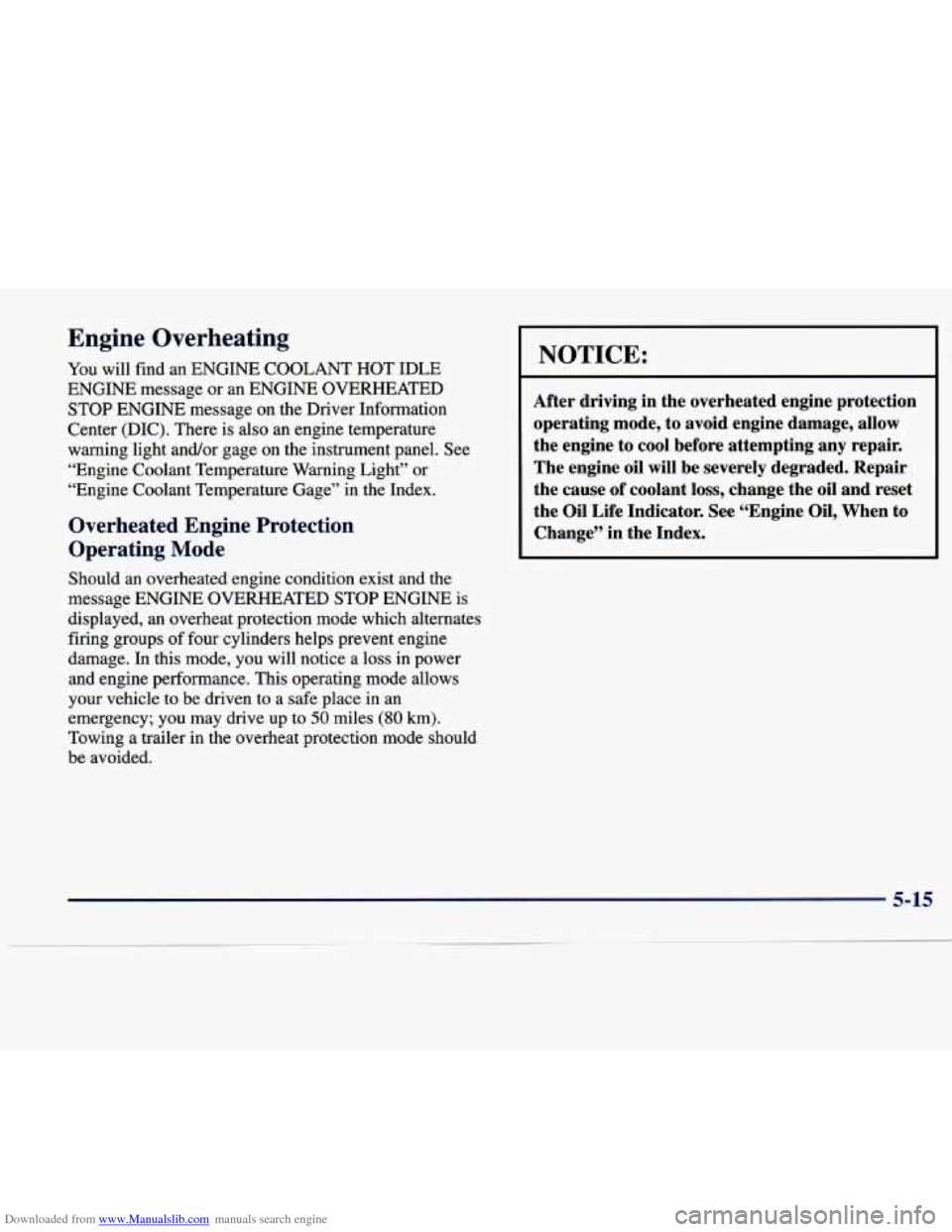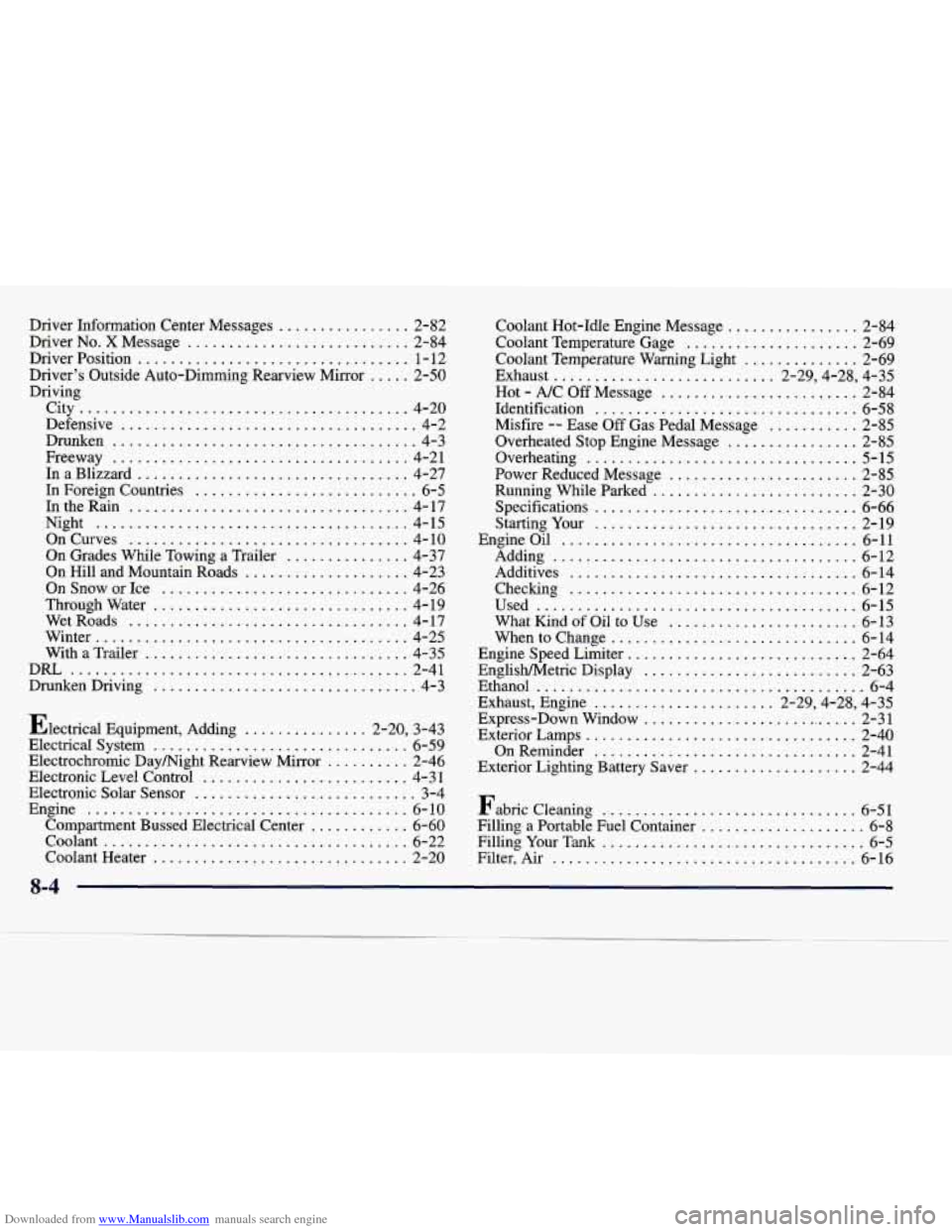1998 CADILLAC SEVILLE heating
[x] Cancel search: heatingPage 238 of 378

Downloaded from www.Manualslib.com manuals search engine ,*a- -a
Section 5 Problems on the Road
Here you’ll find what to do about some problems that can occur on the road.
5-2
5-3
5-3
5-8
5- 15
Hazard Warning Flashers Other Warning Devices
Jump Starting
Towing Your Vehicle
Engine Overheating 5-24 If a Tire Goes Flat
5-24 Changing a Flat Tire
5-35 Compact Spare Tire
5-36 If You’re Stuck: In Sand, Mud, Ice or Snow
Page 252 of 378

Downloaded from www.Manualslib.com manuals search engine Engine Overheating
You will find an ENGINE COOLANT HOT IDLE
ENGINE message or an ENGINE OVERHEATED
STOP ENGINE message on the Driver Information
Center (DIC). There is also an engine temperature
warning light and/or gage on the instrument panel. See
“Engine Coolant Temperature Warning Light” or
“Engine Coolant Temperature Gage” in the Index.
Overheated Engine Protection
Operating Mode
NOTICE:
After driving in the overheated engine protection
operating mode, to avoid engine damage, allow
the engine to cool before attempting any repair.
The engine oil will be severely degraded. Repair
the cause
of coolant loss, change the oil and reset
the Oil Life Indicator. See “Engine Oil, When to
Change” in the Index.
Should an overheated engine condition exist and the
message ENGINE
OVERHEATED STOP ENGINE is
displayed, an overheat protection mode which alternates
firing groups
of four cylinders helps prevent engine
damage. In this mode, you will notice
a loss in power
and engine performance. This operating mode allows
your vehicle to be driven to
a safe place in an
emergency; you may drive up
to 50 miles (SO km).
Towing a trailer in
the overheat protection mode should
be avoided.
5-15
Page 256 of 378

Downloaded from www.Manualslib.com manuals search engine If it isn’t, the coolant level should be indicated by a
CHECK COOLANT LEVEL message on the Driver
Information Center. If it is, you may have
a leak in the
radiator hoses, heater hoses, radiator, water
pump or
somewhere else
in the cooling system.
Heater and radiator hoses, and other engine
parts, can be
very hot. Don’t touch them. If you
do, you can be burned.
Don’t run the engine
if there is a leak. If you run
the engine, it could lose all coolant. That could
cause an engine fire, and you could be burned.
Get any leak filed before you drive the vehicle.
NOTICE:
Engine damage if you keep running your engine
without coolant isn’t covered
by your warranty.
See “Overheated Engine Protection Operating
Mode” in the Index.
If there seems to be no leak, with the engine on, check to
see if the electric engine cooling fans are running. If the
engine is overheating, both fans should be running.
If
they aren’t, your vehicle needs service.
5-19
Page 297 of 378

Downloaded from www.Manualslib.com manuals search engine How to Reset tk I ’I’ - ~- -- 3 Change
Indicator
After the transaxle fluid has been changed, display the
TRANS FLUID LIFE message by pressing the
INFO
button. Then press and hold the INFO RESET button
until the display shows
“loo.” This resets the transaxle
fluid life index. The message will remain off until the next transaxle fluid change is needed. The percentage
of
transaxle fluid life remaining may be checked at any
time by pressing the
INFO button several times until the
TRANS FLUID LIFE message appears.
Engine Coolant
The cooling s stem in your vehicle is filled with
DEX-COOL engine coolant. This coolant is designed
to remain in your vehicle for 5 years or 150,000 miles
(240 000 km) whichever occurs first, if you add only
DEX-COOL’ extended life coolant.
B
The following explains your cooling system and how to
add coolant when it is low.
If you have a problem with
engine overheating, see “Engine Overheating” in
the Index.
A 50/50 mixture of water and DEX-COOL@
coolant will:
0 Give freezing protection down to -34°F (-37°C).
0 Give boiling protection up to 265°F (129°C).
Protect against rust and corrosion.
Help keep the proper engine temperature.
0 Let the warning lights and gages work as
they should.
NOTICE:
When adding coolant, it is important that you use
only
DEX-COOL@ (silicate-free) coolant.
If coolant other than DEX-COOL is added to the
system, premature engine, heater core or
radiator corrosion may result. In addition, the
engine coolant will require change sooner
-- at
30,000 miles (50 000 km) or 24 months,
whichever occurs first. Damage caused
by the use
of coolant other than DEX-COOL@ is not
covered
by your new vehicle warranty.
6-22
Page 300 of 378

Downloaded from www.Manualslib.com manuals search engine Adding Coolant
If you need more coolant, add the proper DEX-COOL@
coolant mixture at the surge tank, but only when the
engine
is cool.
I A CAUTION: I
You can be burned if you spill coolant on hot
engine parts. Coolant contains ethylene glycol,
and it will burn if the engine parts are hot
enough. Don’t spill coolant on
a hot engine.
~~
When replacing the surge tank pressure cap, make sure
it is tight.
Surge Tank Pressure Cap
I NOTICE:
The surge tank cap is a 15 psi (105 kPa)
pressure-type cap and must be tightly installed to
prevent coolant loss and possible engine damage
from overheating.
Two and one-half turns are
required to
seal the cap.
If the surge tank pressure cap needs to be replaced, a
GM cap is recommended.
Thermostat
Engine coolant temperature is controlled by a thermostat
in the engine coolant system. The thermostat stops the
flow of coolant through the radiator until the coolant
reaches a preset temperature.
If your thermostat needs to be replaced, a GM
thermostat is recommended.
6-25
Page 317 of 378

Downloaded from www.Manualslib.com manuals search engine A CAUTION:
Poorly maintained and improperly used tires
are dangerous.
e
e
e
Overloading your tires can cause
overheating as
a result of too much friction.
You could have an air-out and a serious
accident. See “Loading Your Vehicle” in
the Index.
Underinflated tires pose the same danger as
overloaded tires. The resulting accident
could cause serious injury. Check all tires
frequently to maintain the recommended
pressure. Tire pressure should be checked
when your tires are cold.
Overinflated
tires are more likely to be
cut, punctured or broken by
a sudden
impact
-- such as when you hit a pothole.
Keep tires
at the recommended pressure.
CAUTION: (Continued)
I CAUTION: (Continued) I
0 Worn, old tires can cause accidents. If your
tread is badly worn, or if your tires have
been damaged, replace them.
See “Inflation
-- Tire Pressure” in this section
for inflation pressure adjustment for higher
speed driving.
Inflation -- Tire Pressure
The Tire-Loading Information label, which is located an
the rear edge of the driver’s door, shows the correct
inflation pressures
for your tires when they’re cold.
“Cold” means your vehicle has been sitting for at least
three hours or driven no more than
1 mile (1.6 km).
If you’ll be driving at high speeds (e.g., speeds of 100 mph
(160 km/h) or higher), where it is legal, set the cold
inflation pressure to the maximum inflation pressure
shown on the tire sidewall, or to
38 psi (265 Wa),
whichever is lower. See the example below. When you end
this high-speed driving, return to the cold inflation
pressure shown on the Tire-Loading Information label.
6-42
Page 339 of 378

Downloaded from www.Manualslib.com manuals search engine Fuse
7
8
9
10
11
12
13
14 15
16
17
18
19
20
21
22
23
Usage
Power Tilt and Telescoping Steering Supplemental Inflation Restraint
Not Used
Lamps
Park Right
Fuel Tank Ventilation Solenoid
Ignition
1
Lamps, Parking Left
Interior Lamp Dimmer Module
Navigation
- Export Only
Heated Seat Left Front
Export Lighting
Rear Door Modules
Stoplamps
Neutral Safety Back-up
Audio
Retained Accessory Power for Sunroof
Not Used
Fuse
24
25
26
27
28
29
30
31
32
33
34
35
36
37
38
Usage
Not Used
Passenger Door Module
Fuel Door/Trunk Release
Interior Lamps
Rear HVAC Blower
Ignition Switch
Not Used Heated Seat Right Front
Continuous Variable Road Sensing
Suspension
Heating, Ventilation, Air Conditioning
Ignition
3 Rear
Antilock Braking System
Turn SignaVHazard Heated Seat Right Rear
Dash Integration Module
6-64
Page 365 of 378

Downloaded from www.Manualslib.com manuals search engine Driver Information Center Messages ................ 2-82
Driver
No . X Message ........................... 2-84
Driver Position
................................. 1-12
Driver’s Outside Auto-Dimming Rearview Mirror
..... 2-50
Driving City
........................................ 4-20
Defensive
.................................... 4-2
Drunken
..................................... 4-3
Freeway
.................................... 4-2 1
InaBlizzard ................................. 4-27
In Foreign Countries
........................... 6-5
In the Rain
.................................. 4-17
Night
...................................... 4-15
OnCurves
.................................. 4-1 0
On Grades While Towing a Trailer ............... 4-37
On
Hill and Mountain Roads .................... 4-23
On Snow or Ice
.............................. 4-26
Through Water
............................... 4- 19
WetRoads .................................. 4-17
Winter
...................................... 4-25
With a Trailer
................................ 4-35
DRL
......................................... 2-41
DrunkenDriving
................................ 4-3
Electrical Equipment. Adding
............... 2-20. 3-43
Electrical System
............................... 6-59
Electrochromic Daymight Rearview Mirror
.......... 2-46
Electronic Level Control ......................... 4-3 1
Electronic Solar Sensor
........................... 3-4
Engine
....................................... 6- 10
Compartment Bussed Electrical Center
............ 6-60
Coolant
..................................... 6-22
Coolant Heater
............................... 2-20 Coolant Hot-Idle Engine Message
................ 2-84
Coolant Temperature Gage
..................... 2-69
Coolant Temperature Warning Light
.............. 2-69
Exhaust
........................... 2-29’4-28’4-35
Hot
- A/C Off Message ........................ 2-84
Identification
................................ 6-58
Misfire .. Ease Off Gas Pedal Message ........... 2-85
Overheated Stop Engine Message
................ 2-85
Overheating
................................. 5-15
Power Reduced Message
....................... 2-85
Running While Parked
......................... 2-30
Specifications
................................ 6-66
StartingYour
................................ 2-19
Engine Oil
.................................... 6-11
Adding
..................................... 6-12
Additives
................................... 6-14
Checking
................................... 6-12
Used
....................................... 6-15
What Kind
of Oil to Use ....................... 6-13
Whentochange
.............................. 6-14
Engine Speed Limiter
............................ 2-64
EnglisWMetric Display
.......................... 2-63
Ethanol
........................................ 6-4
Exhaust. Engine
...................... 2-29,4-28, 4-35
Express-Down Window
........................... 2-31
Exterior Lamps
................................. 2-40
Exterior Lighting Battery Saver
.................... 2-44
OnReminder
................................ 2-41
Fabric Cleaning
............................... 6-51
Filling a Portable Fuel Container
.................... 6-8
Filter. Air
..................................... 6-16
FillingYourTank
................................ 6-5
8-4